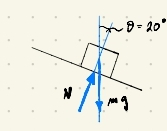If fricction can be disregarded, it means that the contact force $N$ between the two blocks will be orthogonal to their common interface (see figure). Furthermore, since the small block is not sliding, it means that it is not moving vertically, so the vertical resultant applied on it must be zero:
$$N\cos{(20)} = mg$$
from which $N$ can already be obtained: $N \approx 20.88 \,\mathrm{N}$.
Also, the horizontal component of the resultant is equal to $a$, the common acceleration of the two blocks, which are moving solidarly:
$$N\sin{(20)} = ma$$
This yields $a \approx 3.57\,\mathrm{m}\mathrm{s}^{-2}$. Finally, the total force applied to the two masses together must fulfill
$$F = (M+m)/a \approx 2.8\,\mathrm{N}$$$$F = (M+m)a \approx 35.7 \,\mathrm{N}$$

